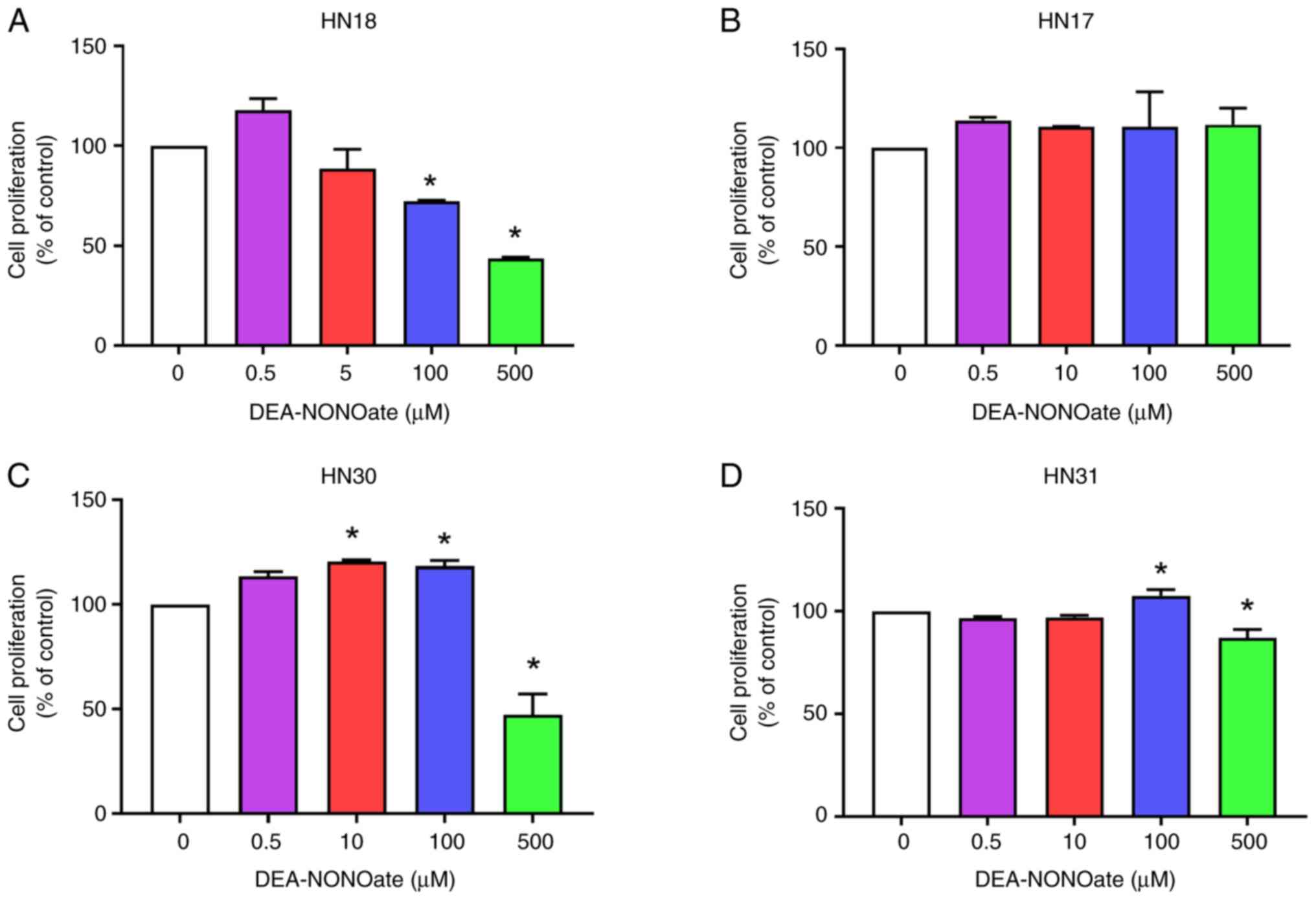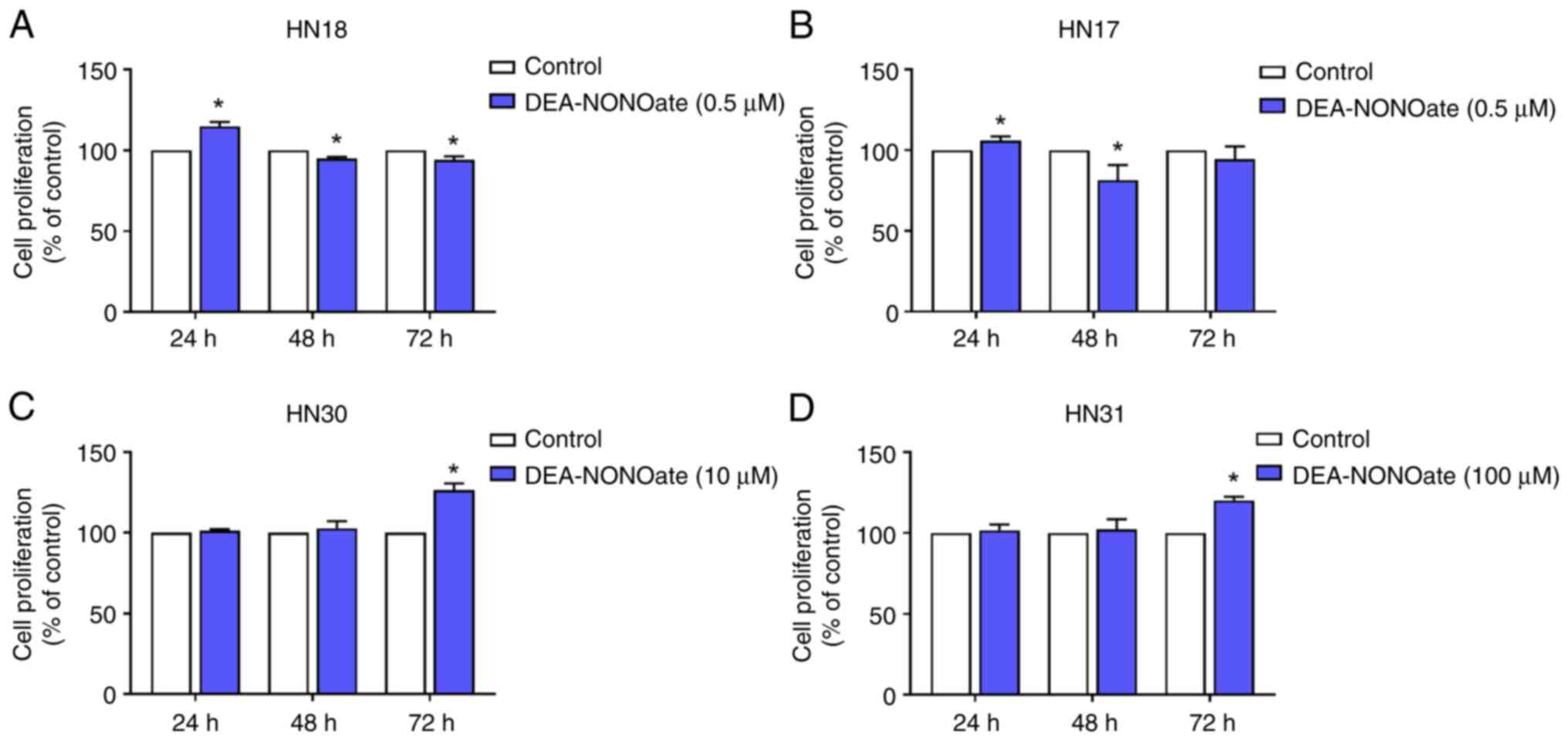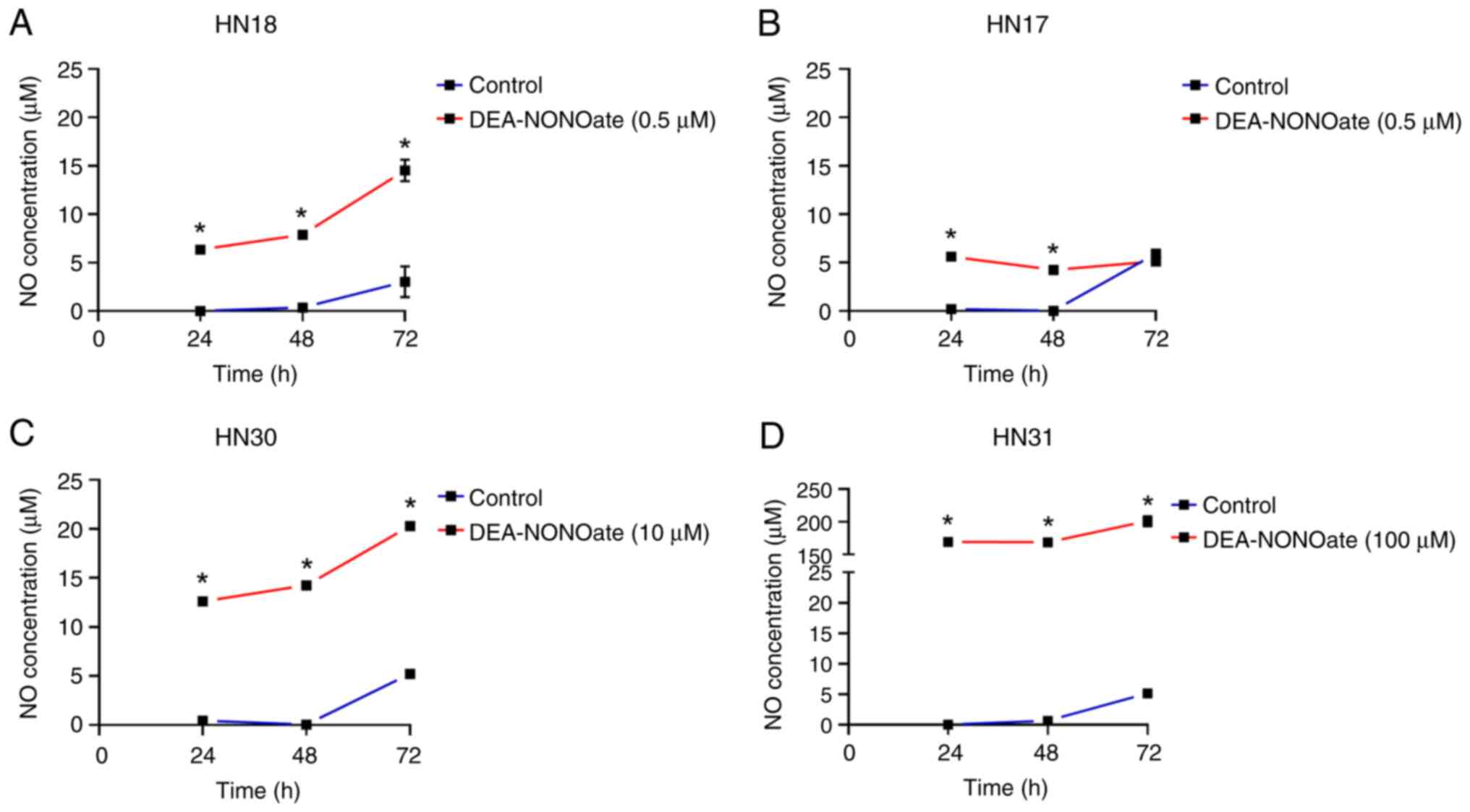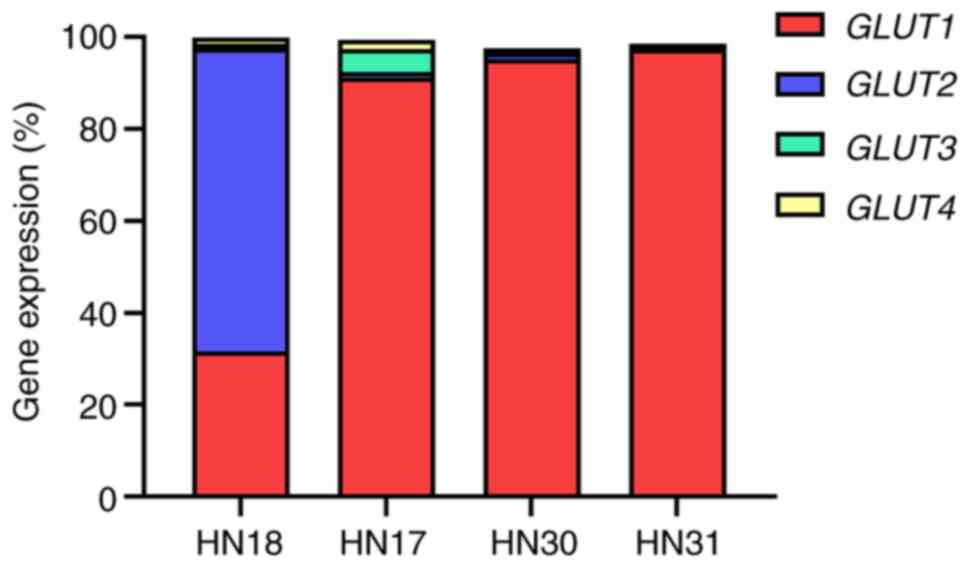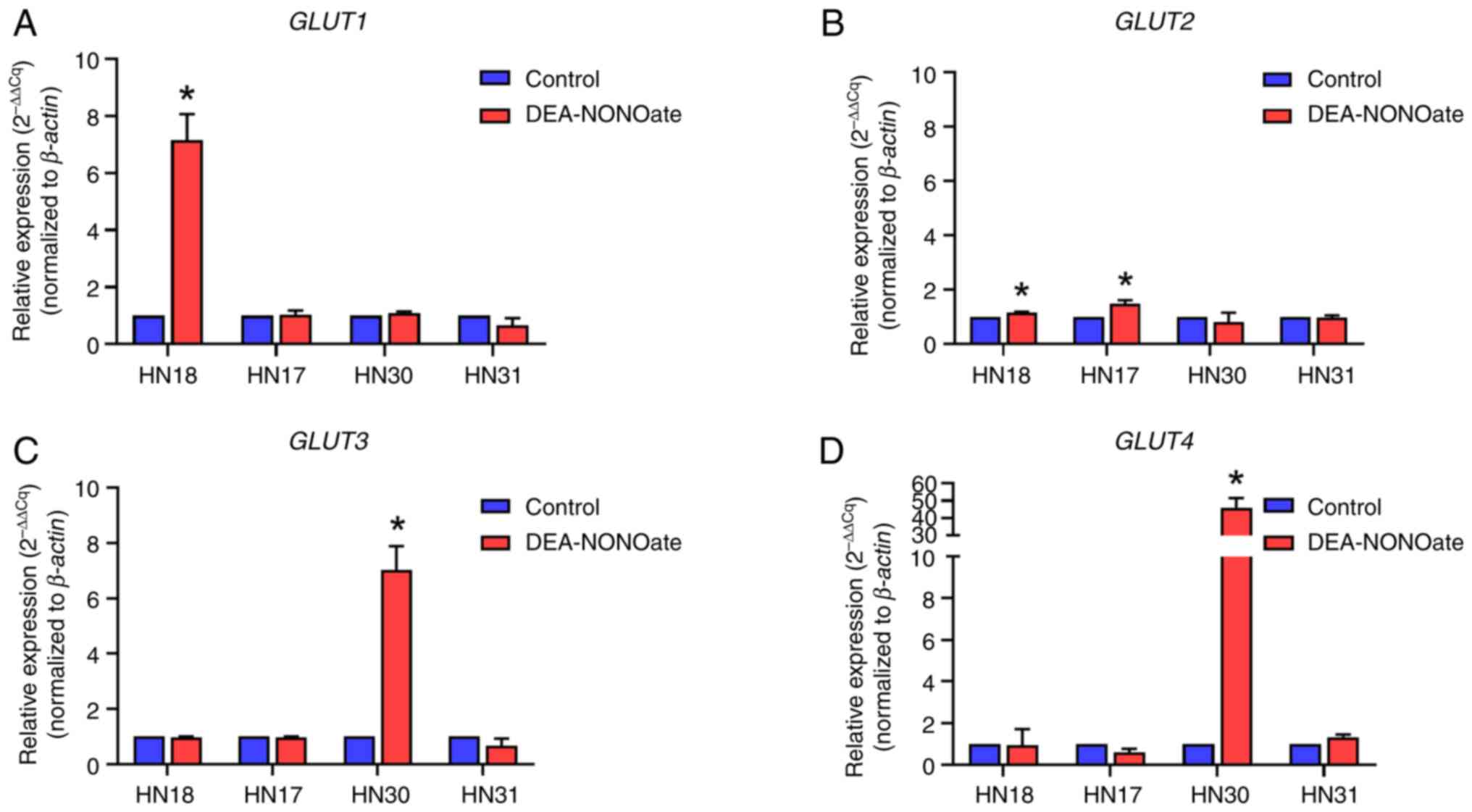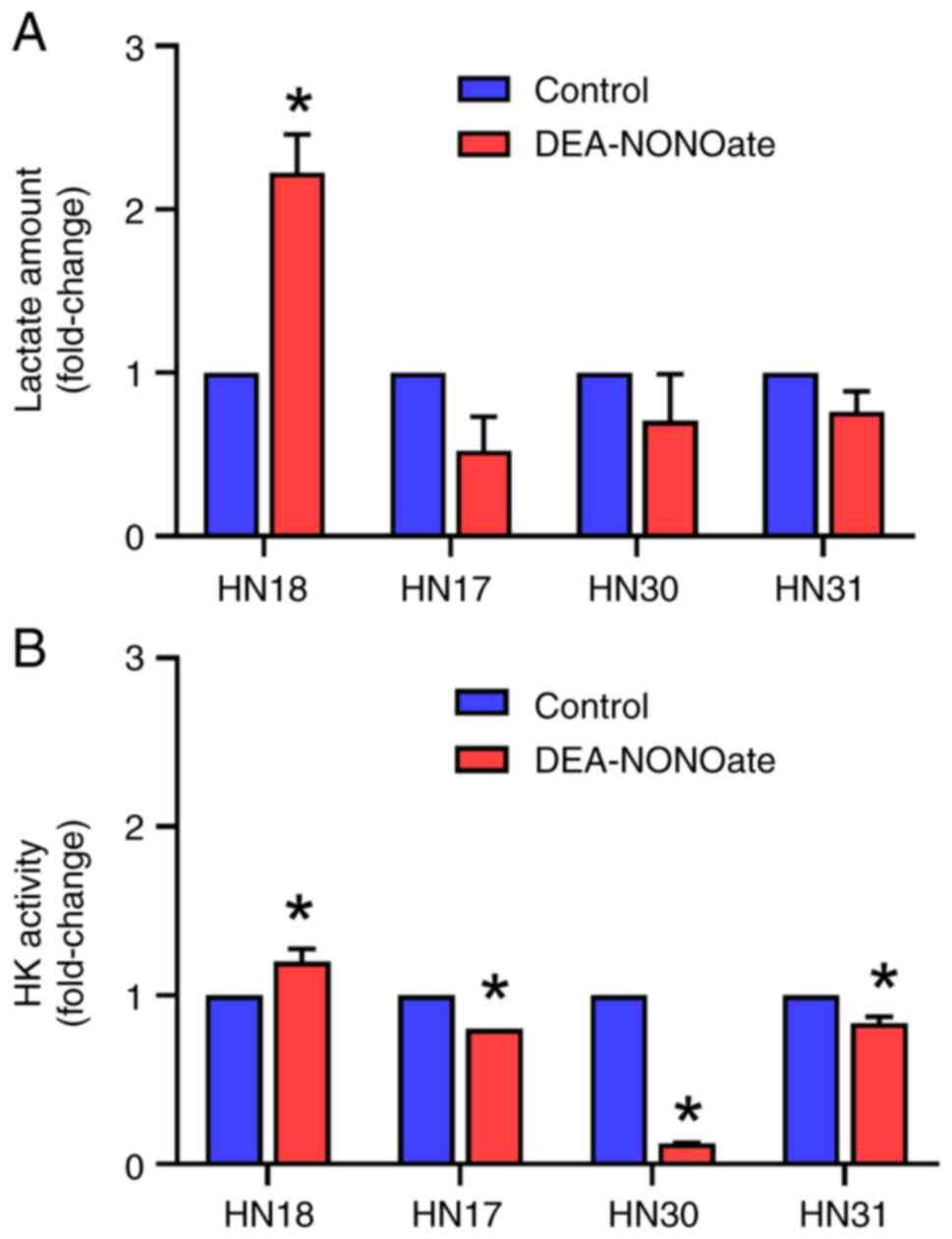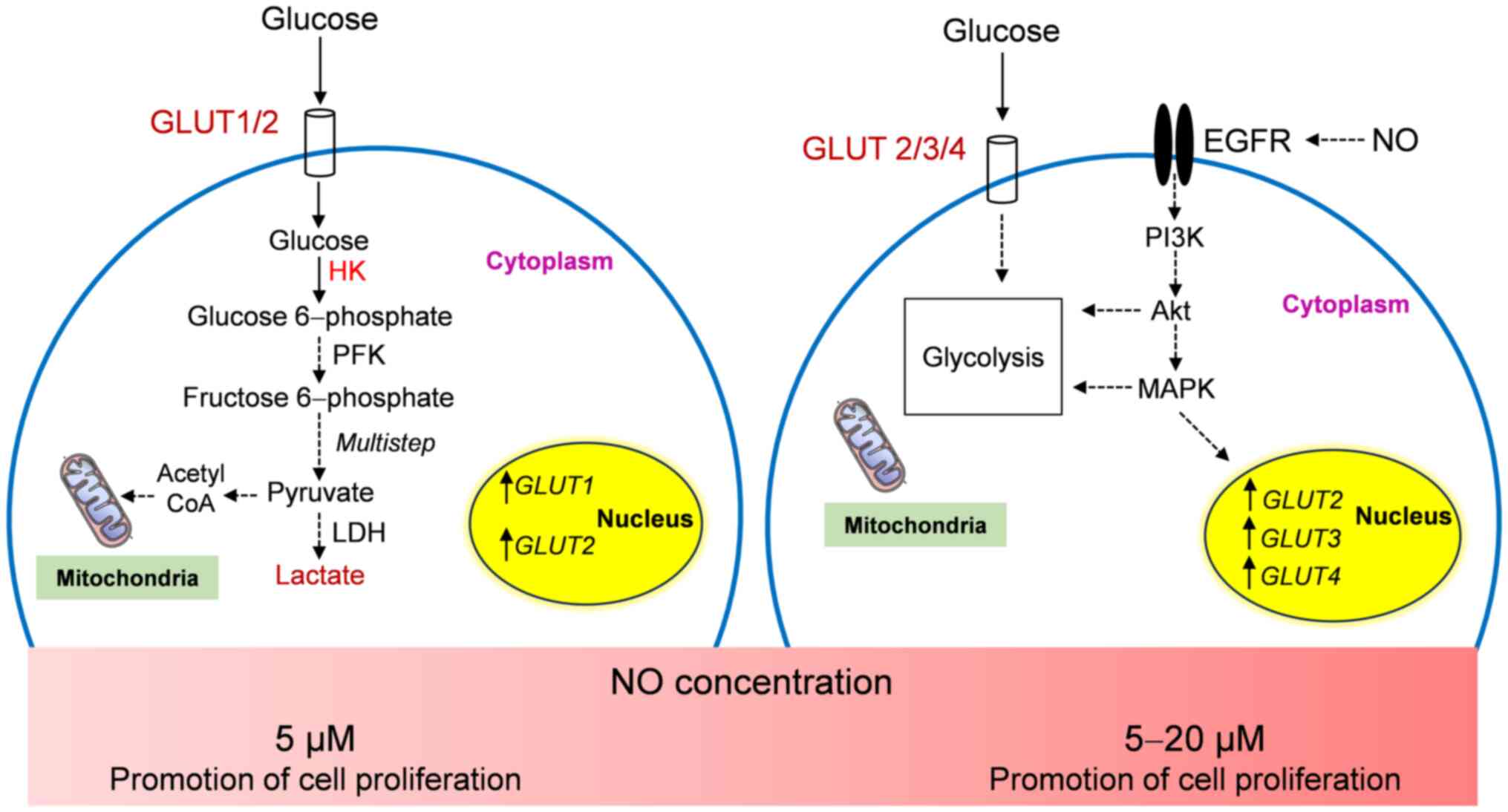Nitric oxide has diverse effects on head and neck cancer cell proliferation and glycolysis
- Authors:
- Published online on: May 30, 2024 https://doi.org/10.3892/br.2024.1794
- Article Number: 106
-
Copyright: © Kokilakanit et al. This is an open access article distributed under the terms of Creative Commons Attribution License.
Abstract
Introduction
Head and neck squamous cell carcinoma (HNSCC) has a high therapeutic failure rate, resulting in low 5-year survival rate (1). Alterations in metabolism, especially glycolysis, in cancer cells have been investigated to determine their potential as a cancer therapy target (2). Changes in glycolysis and associated signaling pathways has been associated with chemoresistance in various types of cancer (3).
Glycolysis is a key metabolic pathway in cancer cells that provides sufficient ATP, nucleotides, lipids, and amino acids for high tumor cell proliferation under aerobic conditions that contribute to tumor progression; this phenomenon is called the ‘Warburg effect’ (4). One of the hallmarks of cancer is a high glycolytic rate in cancer cells that is characterized by two key biochemical steps: Increased glucose uptake and conversion of glucose into lactate. The increased glucose uptake in cancer cells is facilitated by upregulating expression of glucose transporters (GLUTs) (5). GLUTs are a transmembrane protein family that is sub-divided into three phylogenetically distinct classes. Class 1 (GLUT1, 2, 3 and 4) has been extensively studied in mammalian cells (6,7). GLUT1 has a high affinity for glucose and is highly expressed in normal cells, including erythrocytes and endothelial cells, and overexpressed in breast (8), gastric (9), colorectal (10) and prostate (11) cancer. Moreover, GLUT1 upregulation is significantly associated with poorly differentiated cancer, positive lymph node metastasis, increased tumor size and worse overall and disease-free survival in patients with various types of cancers, such as gastric, colorectal, breast, pancreatic, liver, lung, ovarian and oral cancer (12). GLUT3 is primarily expressed in the nervous system and has a higher affinity for glucose than GLUT1(13). GLUT3 is overexpressed in glioblastoma (14) and gastric (15) and non-small cell lung cancer (16). GLUT2 is constitutively expressed in the intestinal absorptive epithelial cells, hepatocytes and pancreatic β and kidney cells (17). GLUT2 is overexpressed in hepatocellular carcinoma cells (18) and colorectal cancer (19). GLUT4 is present in insulin-sensitive tissue, including adipose, heart and skeletal muscle. However, the expression of GLUT4 varies in ovarian and renal cancer (5).
Hexokinases (HKs), phosphofructokinase (PFK) and pyruvate kinase are rate-limiting enzymes in glycolysis and play important roles in catalyzing conversion of glucose to lactate (20). Increased activity of these glycolytic enzymes and upregulated lactate production are associated with tumor progression, such as tumor growth, chemoresistance and metastasis (21).
Nitric oxide (NO), a free radical that is highly reactive and diffusible, exhibits dual roles in the physiological maintenance and pathology of disease, including cancer (22). High NO levels cause nitrosative stress that affects homeostasis and alters protein function (23). Depending on the cancer type and NO concentration, NO modulates different aspects of cancer aggressiveness, including angiogenesis, apoptosis, cell cycle, invasion and metastasis (24). A high NO concentration induces HNSCC cell adaptability, such as survival, invasion and autophagy enhancement (25,26).
To the best of our knowledge, there is limited information on the effect of NO on glycolysis in cancer cells. In ovarian cancer, low NO concentration (≤100 nM) promote glycolysis, resulting in ATP production, oxidative defense and cell proliferation, whereas high NO concentration (≥500 nM) inhibits glycolysis and tumor progression (27). Based on the aforementioned roles of NO on tumor progression in HNSCC, it was hypothesized that NO might drive these tumorigenic behaviors via its effects on glycolysis. To the best of our knowledge, however, there is no evidence of the effect of NO on glycolysis in HNSCC. Therefore, the aim of the present study was to investigate the effects of NO on HNSCC cell proliferation and glycolytic intermediates including GLUT1-4 gene expression, HK activity and lactate production.
Materials and methods
Cell culture
The isogenic primary and metastatic HNSCC cell lines were from the same patient and were initially established by Cardinali et al (28) and provided by Professor Silvio Gutkind (Moores Cancer Center, Department of Pharmacology, UC San Diego, USA). HN18 cells were obtained from primary tongue lesions and the HN17 cells were isolated from neck dissections (T2N2M0 stage). HN30 cells were obtained from primary pharynx lesions and HN31 cells were isolated from lymph node metastases (T3N1M0 stage). The cells were cultured in DMEM (Invitrogen; Thermo Fisher Scientific, Inc.) supplemented with 10% fetal bovine serum (Invitrogen; Thermo Fisher Scientific, Inc.), 100 U/ml penicillin and 100 µg/ml streptomycin at 37˚C in a 5% CO2 atmosphere.
MTT assay
HNSCC cell lines were cultured in 96-well plates (2,000 cells/well) at 37˚C for 24 h. Based on preliminary experiments (data not shown), diethylamine NONOate(DEA-NONOate) concentrations that affected the mean % cell proliferation within the 95% confidence interval were selected for investigation of the proliferative effect on each cell line in the present study. NO donor, DEA-NONOate (Sigma-Aldrich; Merck KGaA) concentrations 0.5, 5.0, 100.0 and 500.0 µM were selected to treat HN18 cells and 0.5, 10.0, 100.0 and 500.0 µM were selected to treat HN17, 30 and 31 cells at 37˚C for 72 h.
The minimum concentration that generated the highest cell proliferation was used as the effective dose for each cell line in subsequent experiments. The effective doses of 0.5, 10.0 and 100.0 µM DEA-NONOate were used to treat HN18 and HN17, HN30 and HN31 cells, respectively, at 37˚C for 24, 48 and 72 h. Cells in DMEM without DEA-NONOate served as control. The cell proliferation in each group was determined using MTT (Sigma-Aldrich; Merck KGaA) assay as previously described (29). Three independent experiments were performed.
NO determination
HNSCC cell lines were cultured and treated as aforementioned. The conditioned media from each condition was collected and stored at -80˚C until analysis. NO secretion was determined using the Griess Reagent System (Promega Corporation) per the manufacturer's instructions. Three separate experiments were conducted.
Reverse transcription-quantitative (RT-q)PCR
HNSCC cells were seeded in 6-well plates (200,000 cells/well) at 37˚C for 24 h. The HN18 and HN17, HN30 and HN31 cells were treated with 0.5, 10.0 and 100.0 µM DEA-NONOate, respectively, at 37˚C for 2 h. Total RNA was extracted using TRIzol (Invitrogen; Thermo Fisher Scientific, Inc.). The total RNA was converted into complementary DNA using a PrimeScript 1st strand cDNA Synthesis kit (Takara Bio, Inc.) per the manufacturer's instructions. The relative GLUT1, 2, 3 and 4 mRNA expression levels were determined using the KAPA SYBR® FAST qPCR Kit Master Mix (Kapa Biosystems) in the QuantStudio™ 3 Real-Time PCR System (Thermo Fisher Scientific, Inc.). The primers were designed by Primer-BLAST online (National Center for Biotechnology Information; ncbi.nlm.nih.gov/tools/primer-blast/; Table I). The thermocycling conditions were as follows: Initial denaturation at 95˚C for 10 min, followed by 40 cycles of denaturation at 95˚C for 15 sec and annealing at 60˚C for 60 sec. The constitutive expression was calculated using the 2-ΔCq equation (30). β-actin was used as a housekeeping gene. ΔCq was calculated as GLUT Cq-β-actin Cq. The percentage of GLUT expression in each cell line was calculated as follows: GLUT expression (%)=[(mean 2-ΔCq of GLUT)/(total 2-ΔCq of GLUTs)] x100. To determine DEA-NONOate-induced GLUT expression in HNSCC cell lines, the relative expression of each GLUT was evaluated using the 2-ΔΔCq method (30) as follows: ΔCq=Cq (treated cells)-Cq (untreated cells). Three independent experiments were conducted.
Lactate quantification
Cells were cultured in 25-cm2 flasks at a density of 100,000 cells/ml for 24 h and treated as aforementioned. The cell suspension was centrifuged at 13,000 x g, 4˚C for 5 min to collect cell pellets. The cell pellets (1x106 cells) were collected and homogenized in 50 µl Lactate Assay buffer. Lactate Assay kit (cat. no. #MAK064; Sigma-Aldrich; Merck KGaA) was used for the lactate production test according to the manufacturer's instructions. Three independent experiments were performed.
HK activity evaluation
The cells were cultured in 25-cm2 flasks at a density of 100,000 cells/ml at 37˚C for 24 h and treated as aforementioned. The cell pellets (1x106 cells) were collected by centrifugation at 13,000 x g, 4˚C for 5 min and homogenized in 100 µl ice-cold HK Assay buffer (Hexokinase Colorimetric Assay kit; cat. no. #MAK091; Sigma-Aldrich; Merck KGaA) according to the manufacturer's instructions. HK activity was determined by its oxidized product (NADH). The samples were measured at an absorbance of 450 nm at the initial time [T(A450)initial] in a MULTISKAN Sky microplate reader (Thermo Fisher Scientific, Inc.). The plates were then incubated at room temperature, and measurements were taken every 5 min for 30 min. A450 at 30 min was defined as final time [T(A450)final]. The change in the measurement from Tinitial to Tfinal for each sample (ΔA450) was calculated as follows: ΔA450=(A450)final-(A450)initial.
The amount of NADH generated between Tinitial and Tfinal was determined by comparing the ΔA450 of each sample to a standard curve. HK activity of each sample was determined as follows: HK activity=[NADH x dilution factor/(Tfinal-Tinitial) x sample volume]. Three independent experiments were performed.
Statistical analysis
All data are presented as the mean ± SEM from three independent experiments. Multiple group comparisons were performed using one-way ANOVA followed by Tukey's post hoc test. Unpaired t test was applied to compare two independent groups. The statistical analyses were performed using Prism GraphPad 9.0 software (GraphPad Software, Inc.; Dotmatics). P≤0.05 was considered to indicate a statistically significant difference.
Results
Effect of DEA-NONOate on HNSCC cell proliferation
HNSCC cell lines were treated with 0.5-500.0 µM DEA-NONOate for 72 h. DEA-NONOate (10-500 µM) decreased HN18 cell proliferation in a dose-dependent manner (Fig. 1A). DEA-NONOate at 0.5 and 5.0 µM demonstrated no significant difference in proliferation in HN18 cell when compared with control. By contrast, DEA-NONOate treatment did not significantly change proliferation in HN17 cells (Fig. 1B). DEA-NONOate significantly increased proliferation in HN30 (10 and 100 µM) and HN31 (100 µM) cells compared with control (Fig. 1C and D). Moreover, 500 µM DEA-NONOate had a cytotoxic effect on HN18, HN30 and HN31 cells (Fig. 1A, C and D).
DEA-NONOate at 0.5, 10.0 and 100.0 µM was used to test proliferation at 24-72 h in HN18 and HN17, HN30 and HN31 cells, respectively. The proliferation significantly increased in DEA-NONOate-treated HN18 and HN17 cells at 24 h compared with control (Fig. 2A and B), however, proliferation significantly declined at 48 to 72 h. DEA-NONOate significantly induced proliferation in HN30 and HN31 cells at 72 h compared with control (Fig. 2C and D). By contrast, at 24-48 h, DEA-NONOate did not affect proliferation of these cell lines.
Therefore, 0.5, 10.0 and 100.0 µM DEA-NONOate was selected as the effective concentration for HN18 and HN17, HN30 and HN31 cells, respectively, in the subsequent experiments.
Determination of NO in DEA-NONOate-treated HNSCC cells
The cells were treated with their effective DEA-NONOate concentration for 24-72 h. NO was secreted from the DEA-NONOate-induced cells and significantly increased in HN18, HN30 and HN31 cells from 24 to 72 h compared with control (Fig. 3A, C and D). The amount of NO released by DEA-NONOate-treated cells was 6.3-14.5 µM in HN18, 12.6-20.3 µM in HN30 and 169.4-201.0 µM in HN31 cells. Although DEA-NONOate significantly induced NO secretion in HN17 cells at 24 and 48 h compared with control (Fig. 3B), its levels remained constant until 72 h. NO secreted from DEA-NONOate-treated HN17 cells was 5.1-5.6 µM.
Gene expression profiling of GLUTs in HNSCC cells
The constitutive expression of GLUT1, 2, 3 and 4 genes in HNSCC cell lines was evaluated before DEA-NONOate induction. The relative expression of GLUT1 was 91.3, 95.1 and 97.3% in HN17, HN30 and HN31 cells, respectively (Fig. 4). The GLUT2 expression (65.9%) was the highest among the GLUTs in HN18 cells.
DEA-NONOate induces GLUT gene expression in HNSCC cells
After DEA-NONOate induction, GLUT1 and 2 expression was significantly increased in HN18 cells compared with control (Fig. 5A and B). GLUT2 expression was significantly increased in DEA-NONOate-induced HN17 cells compared with control (Fig. 5B). Moreover, GLUT3 and 4 expression was significantly increased in DEA-NONOate-induced HN30 cells compared with control (Fig. 5C and D). However, there was no alteration in GLUT1, 2, 3 and 4 expression following DEA-NONOate induction in HN31 cells (Fig. 5).
Effect of DEA-NONOate on lactate amount and HK activity in HNSCC cells
The lactate amount in DEA-NONOate-treated HN18 cells significantly increased to 5.15 pmol or 2.22-fold of control (Fig. 6A). However, the lactate levels in HN17, HN30 and HN31 cells were not affected by DEA-NONOate. Furthermore, DEA-NONOate significantly induced HK activity in HN18 cells to 20.36 milliunits/ml or 1.20-fold of control (Fig. 6B). By contrast, the HK activity in HN17, HN30 and HN31 cells significantly decreased following DEA-NONOate treatment.
Discussion
The present study investigated the effects of DEA-NONOate on proliferation and glycolysis in HNSCC cell lines. Based on its concentration, DEA-NONOate exhibited disparate effects on proliferation, GLUTs expression, HK activity and lactate production between HNSCC cell lines. NO has a biphasic function in the tumor microenvironment (31). NO exhibits pro- and anti-tumor mechanisms depending on its concentration and cancer type (24). NO at 10-30 nM promotes pro-tumorigenic mechanisms, such as ERK pathway activation; NO >1 µM increases nitrative stress and apoptosis in a breast cancer cell line (32). In ovarian cancer, NO ≤100 nM promotes glycolysis and cell proliferation, whereas NO ≥500 nM exhibits antitumorigenic effects (27).
In the present study, DEA-NONOate was used as a NO donor to induce proliferation and glycolysis in HNSCC cells. DEA-NONOate significantly promoted HNSCC cell proliferation at different concentrations and induction periods; 0.5 µM DEA-NONOate increased proliferation in HN18 and HN17 cells at 24 h, whereas 10 and 100 µM DEA-NONOate induced proliferation in HN30 and HN31 cells at 72 h. Moreover, overall, the anti-proliferative concentration of DEA-NONOate for HNSCC cells was >200 µM. These effective concentrations of NO on HNSCC cells were relatively higher than those of other cancers, as aforementioned. Moreover, the present study demonstrated that the effect of NO on HNSCC cell proliferation might depend on TNM staging and NO concentration.
Although NO-associated oncogenic signaling has been described with respect to NO concentration in certain types of cancer cells (24), to the best of our knowledge, there is no information on the impact of NO on the metabolic pathways that modulate cancer cell activity. Glycolysis is the primary metabolic pathway that supports tumor progression, which is known as the ‘Warberg effect’ (4). GLUT1-4 are upstream proteins that facilitate glucose entry into the glycolysis pathway, providing high levels of ATP in cancer cells (17). GLUT1 upregulation is widely detected in cancer, including oral cancer tissue, and is significantly associated with poorly differentiated cancer, positive lymph node metastasis, increased tumor size and worse overall survival in patients (12). GLUT2 is overexpressed in hepatocellular carcinoma cells (18) and colorectal cancer (19). In the present study, the GLUT1 gene had relatively high expression levels in HN17, HN30 and HN31 cells compared with the other GLUTs. GLUT2 gene showed the highest expression in HN18 cells. However, the present study had some limitations. GLUTs expression were verified at the mRNA level but not the protein level. In addition, only two pairs of cell lines were tested; the study of other HNSCC cell lines is necessary to validate the findings within the broader spectrum of HNSCC.
A previous study reported that NO promotes glycolysis in ovarian cancer by increasing gene expression of GLUT1, HK, PFK and lactate dehydrogenase (27). The present study partially confirmed that DEA-NONOate induced glycolysis in HN18 cells by increasing the gene expression of GLUT1 and GLUT2, HK activity and lactate production. Although the GLUT2, GLUT3 and GLUT4 genes were upregulated, HK activity decreased and the lactate amount did not significantly change in DEA-NONOate-treated HN17 and HN30 cells. GLUT2 has a very low affinity for glucose and fructose (33). In the present study, the higher expression of GLUT2 in the DEA-NONOate-induced HN18 cells might be sufficient for increased glucose influx and glycolysis compared with HN17 cells. Previous studies found that NO induces breast cancer cell proliferation via non-glycolysis pathways, such as EGF receptor (EGFR), PI3K/AKT and MAPK (34-36). Notably, EGFR is constitutively expressed in the HNSCC cell lines used in the present study (28). To confirm the effect of NO on HNSCC cell proliferation, the glucose uptake and non-glycolysis pathways should be assessed in additional studies. GLUT4 is the insulin-responsive glucose transporter, therefore, glucose uptake is dependent on insulin stimulation in cancer cell lines (5). GLUT4 expression levels are highly associated with insulin-like growth factor (IGF) and associated with the survival of patients with colorectal cancer (37). Based on the present data, the crosstalk between GLUT4 and the IGF signaling pathway should be evaluated prior to interpreting the effect of NO on HN30 cell proliferation.
In conclusion, the present study demonstrated the effects of DEA-NONOate on HNSCC cell proliferation and glycolysis. DEA-NONOate exhibited pro-and anti-proliferative effects in HNSCC cell lines depending on its concentration and TNM staging. NO at lower concentrations (10-200 µM) had pro-proliferative effects, whereas >200 µM had an anti-proliferative effect on the HNSCC cells. NO (5 µM) promoted proliferation and glycolysis in HN18 cell by upregulating GLUT1 and GLUT2 gene expression and increasing HK activity and lactate amount. At 5-20 µM, NO-induced HN17 and HN30 cells demonstrated increased proliferation and GLUT2, GLUT3 and GLUT4 gene expression, however, the glycolytic pathway was not affected. The proposed proliferative mechanism of NO in HNSCC cells is presented in Fig. 7. However, the pro-proliferative concentration of NO (200 µM) induced HN31 cell proliferation without glycolysis activation. Therefore, the pro-tumorigenic effects of NO on HNSCC cells on glycolysis and non-glycolysis mechanisms should be evaluated. Further investigation into crosstalk between the proliferation-related signaling pathways and glycolysis in HNSCC cells is needed.
Acknowledgements
The authors would like to thank Professor Silvio Gutkind (Moores Cancer Center, Department of Pharmacology, UC San Diego, San Diego, USA) for providing the HNSCC cell lines.
Funding
Funding: The present study was supported by the Thammasat University Research Fund (grant no. TUFT 94/2564).
Availability of data and materials
The data generated in the present study may be requested from the corresponding author.
Authors' contributions
KU and SK designed the experiments. KU and PK performed the experiments. KU analyzed the data and wrote the manuscript. KU and SK confirm the authenticity of all the raw data. All authors have read and approved the final manuscript.
Ethics approval and consent to participate
Not applicable.
Patient consent for publication
Not applicable.
Competing interests
The authors declare that they have no competing interests.
References
|
Argiris A, Karamouzis MV, Raben D and Ferris RL: Head and neck cancer. Lancet. 371:1695–1709. 2008.PubMed/NCBI View Article : Google Scholar | |
|
Ma L and Zong X: Metabolic symbiosis in chemoresistance: Refocusing the role of aerobic glycolysis. Front Oncol. 10(5)2020.PubMed/NCBI View Article : Google Scholar | |
|
Visioli F, Wang Y, Alam GN, Ning Y, Rados PV, Nor JE and Polverini PJ: Glucose-regulated protein 78 (Grp78) confers chemoresistance to tumor endothelial cells under acidic stress. PLoS One. 9(e101053)2014.PubMed/NCBI View Article : Google Scholar | |
|
Warburg O: The metabolism of carcinoma cells. J Cancer Res. 9:148–163. 1925. | |
|
Szablewski L: Glucose transporters as markers of diagnosis and prognosis in cancer diseases. Oncol Rev. 16(561)2022.PubMed/NCBI View Article : Google Scholar | |
|
Holman GD: Structure, function and regulation of mammalian glucose transporters of the SLC2 family. Pflugers Arch. 472:1155–1175. 2020.PubMed/NCBI View Article : Google Scholar | |
|
Gould GW and Holman GD: The glucose transporter family: Structure, function and tissue-specific expression. Biochem J. 295 (Pt 2):329–341. 1993.PubMed/NCBI View Article : Google Scholar | |
|
Barbosa AM and Martel F: Targeting glucose transporters for breast cancer therapy: The effect of natural and synthetic compounds. Cancers (Basel). 12(154)2020.PubMed/NCBI View Article : Google Scholar | |
|
Ding X, Liu J, Liu T, Ma Z, Wen D and Zhu J: miR-148b inhibits glycolysis in gastric cancer through targeting SLC2A1. Cancer Med. 6:1301–1310. 2017.PubMed/NCBI View Article : Google Scholar | |
|
Gou Q, Dong C, Jin J, Liu Q, Lu W, Shi J and Hou Y: PPARα agonist alleviates tumor growth and chemo-resistance associated with the inhibition of glucose metabolic pathway. Eur J Pharmacol. 863(172664)2019.PubMed/NCBI View Article : Google Scholar | |
|
Xiao H, Wang J, Yan W, Cui Y, Chen Z, Gao X, Wen X and Chen J: GLUT1 regulates cell glycolysis and proliferation in prostate cancer. Prostate. 78:86–94. 2018.PubMed/NCBI View Article : Google Scholar | |
|
Yu M, Yongzhi H, Chen S, Luo X, Lin Y, Zhou Y, Jin H, Hou B, Deng Y, Tu L and Jian Z: The prognostic value of GLUT1 in cancers: A systematic review and meta-analysis. Oncotarget. 8:43356–43367. 2017.PubMed/NCBI View Article : Google Scholar | |
|
Simpson IA, Dwyer D, Malide D, Moley KH, Travis A and Vannucci SJ: The facilitative glucose transporter GLUT3: 20 years of distinction. Am J Physiol Endocrinol Metab. 295:E242–E253. 2008.PubMed/NCBI View Article : Google Scholar | |
|
Libby CJ, Gc S, Benavides GA, Fisher JL, Williford SE, Zhang S, Tran AN, Gordon ER, Jones AB, Tuy K, et al: A role for GLUT3 in glioblastoma cell invasion that is not recapitulated by GLUT1. Cell Adh Migr. 15:101–115. 2021.PubMed/NCBI View Article : Google Scholar | |
|
He Z, Chen D, Wu J, Sui C, Deng X, Zhang P, Chen Z, Liu D, Yu J, Shi J, et al: Yes associated protein 1 promotes resistance to 5-fluorouracil in gastric cancer by regulating GLUT3-dependent glycometabolism reprogramming of tumor-associated macrophages. Arch Biochem Biophys. 702(108838)2021.PubMed/NCBI View Article : Google Scholar | |
|
Ali A, Levantini E, Fhu CW, Teo JT, Clohessy JG, Goggi JL, Wu CS, Chen L, Chin TM and Tenen DG: CAV1-GLUT3 signaling is important for cellular energy and can be targeted by atorvastatin in non-small cell lung cancer. Theranostics. 9:6157–6174. 2019.PubMed/NCBI View Article : Google Scholar | |
|
Pliszka M and Szablewski L: Glucose Transporters as a target for anticancer therapy. Cancers (Basel). 13(4184)2021.PubMed/NCBI View Article : Google Scholar | |
|
Daskalow K, Pfander D, Weichert W, Rohwer N, Thelen A, Neuhaus P, Jonas S, Wiedenmann B, Benckert C and Cramer T: Distinct temporospatial expression patterns of glycolysis-related proteins in human hepatocellular carcinoma. Histochem Cell Biol. 132:21–31. 2009.PubMed/NCBI View Article : Google Scholar | |
|
Godoy A, Ulloa V, Rodriguez F, Reinicke K, Yanez AJ, Garcia Mde L, Medina RA, Carrasco M, Barberis S, Castro T, et al: Differential subcellular distribution of glucose transporters GLUT1-6 and GLUT9 in human cancer: Ultrastructural localization of GLUT1 and GLUT5 in breast tumor tissues. J Cell Physiol. 207:614–627. 2006.PubMed/NCBI View Article : Google Scholar | |
|
Masters C: Cellular differentiation and the microcompartmentation of glycolysis. Mech Ageing Dev. 61:11–22. 1991.PubMed/NCBI View Article : Google Scholar | |
|
Ganapathy-Kanniappan S and Geschwind JF: Tumor glycolysis as a target for cancer therapy: Progress and prospects. Mol Cancer. 12(152)2013.PubMed/NCBI View Article : Google Scholar | |
|
Lopez-Sanchez LM, Aranda E and Rodriguez-Ariza A: Nitric oxide and tumor metabolic reprogramming. Biochem Pharmacol. 176(113769)2020.PubMed/NCBI View Article : Google Scholar | |
|
Mintz J, Vedenko A, Rosete O, Shah K, Goldstein G, Hare JM, Ramasamy R and Arora H: Current advances of nitric oxide in cancer and anticancer therapeutics. Vaccines (Basel). 9(94)2021.PubMed/NCBI View Article : Google Scholar | |
|
Choudhari SK, Chaudhary M, Bagde S, Gadbail AR and Joshi V: Nitric oxide and cancer: A review. World J Surg Oncol. 11(118)2013.PubMed/NCBI View Article : Google Scholar | |
|
Selvido ID, Koontongkaew S, Kokilakanit P, Sacharoen A, Korsuwannawong S and Utispan K: High nitric oxide-adapted head and neck cancer cell lines demonstrate altered autophagy and apoptosis. J Dent Sci. 19:855–864. 2024.PubMed/NCBI View Article : Google Scholar | |
|
Utispan K and Koontongkaew S: High nitric oxide adaptation in isogenic primary and metastatic head and neck cancer cells. Anticancer Res. 40:2657–2665. 2020.PubMed/NCBI View Article : Google Scholar | |
|
Li L, Zhu L, Hao B, Gao W, Wang Q, Li K, Wang M, Huang M, Liu Z, Yang Q, et al: iNOS-derived nitric oxide promotes glycolysis by inducing pyruvate kinase M2 nuclear translocation in ovarian cancer. Oncotarget. 8:33047–33063. 2017.PubMed/NCBI View Article : Google Scholar | |
|
Cardinali M, Pietraszkiewicz H, Ensley JF and Robbins KC: Tyrosine phosphorylation as a marker for aberrantly regulated growth-promoting pathways in cell lines derived from head and neck malignancies. Int J Cancer. 61:98–103. 1995.PubMed/NCBI View Article : Google Scholar | |
|
Utispan K and Koontongkaew S: Mucin 1 regulates the hypoxia response in head and neck cancer cells. J Pharmacol Sci. 147:331–339. 2021.PubMed/NCBI View Article : Google Scholar | |
|
Rao X, Huang X, Zhou Z and Lin X: An improvement of the 2^(-delta delta CT) method for quantitative real-time polymerase chain reaction data analysis. Biostat Bioinforma Biomath. 3:71–85. 2013.PubMed/NCBI | |
|
Ying L and Hofseth LJ: An emerging role for endothelial nitric oxide synthase in chronic inflammation and cancer. Cancer Res. 67:1407–1410. 2007.PubMed/NCBI View Article : Google Scholar | |
|
Thomas DD, Ridnour LA, Espey MG, Donzelli S, Ambs S, Hussain SP, Harris CC, DeGraff W, Roberts DD, Mitchell JB and Wink DA: Superoxide fluxes limit nitric oxide-induced signaling. J Biol Chem. 281:25984–25993. 2006.PubMed/NCBI View Article : Google Scholar | |
|
Gould GW, Thomas HM, Jess TJ and Bell GI: Expression of human glucose transporters in Xenopus oocytes: Kinetic characterization and substrate specificities of the erythrocyte, liver, and brain isoforms. Biochemistry. 30:5139–5145. 1991.PubMed/NCBI View Article : Google Scholar | |
|
Pervin S, Singh R, Hernandez E, Wu G and Chaudhuri G: Nitric oxide in physiologic concentrations targets the translational machinery to increase the proliferation of human breast cancer cells: Involvement of mammalian target of rapamycin/eIF4E pathway. Cancer Res. 67:289–299. 2007.PubMed/NCBI View Article : Google Scholar | |
|
Ridnour LA, Barasch KM, Windhausen AN, Dorsey TH, Lizardo MM, Yfantis HG, Lee DH, Switzer CH, Cheng RY, Heinecke JL, et al: Nitric oxide synthase and breast cancer: Role of TIMP-1 in NO-mediated Akt activation. PLoS One. 7(e44081)2012.PubMed/NCBI View Article : Google Scholar | |
|
Switzer CH, Glynn SA, Cheng RY, Ridnour LA, Green JE, Ambs S and Wink DA: S-nitrosylation of EGFR and Src activates an oncogenic signaling network in human basal-like breast cancer. Mol Cancer Res. 10:1203–1215. 2012.PubMed/NCBI View Article : Google Scholar | |
|
Chen CL, Chang YC and Hsiao M: Rab GTPases accelerates GLUT4 translocation in colorectal cancer progression by Insulin/IGF system. FASEB J. 34:1. 2020. |



